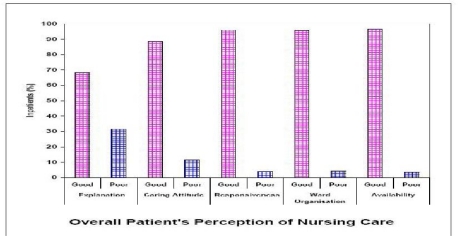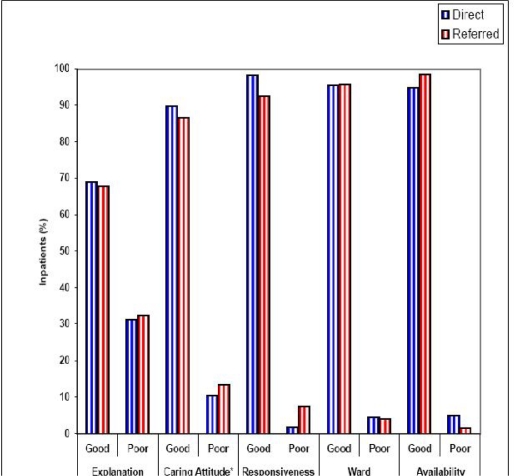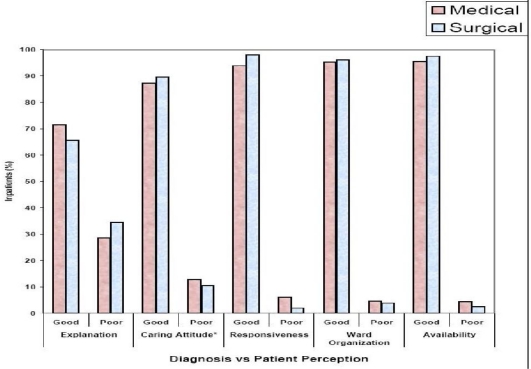Abstract
Background:
As focus has shifted from the healthcare providers to the healthcare consumers; patient satisfaction is being increasingly used worldwide for the assessment of quality of services provided by healthcare institutions. To understand patient satisfaction, “patient’s perception” of care must first be understood. Of all the healthcare workers nurses spend maximum time with the patients. Therefore, the nurse is in a unique position to influence and promote effective consumer relationships. Though patient satisfaction surveys with nursing care are routinely conducted in the developed world to monitor and improve the quality of care, the same is not true for the developing world especially in the Indian subcontinent.
Objective:
To conduct a study of patient’s perception of nursing care in a large teaching hospital.
Methods:
A prospective study spread over a period of one year was carried out. Sample size consisted of seven percent of patients each admitted as emergency and routine. All the randomly selected patients were administered questionnaires, thus obtaining a sample size of 2600. Of these 2500 questionnaires were usable for data analysis (valid response rate of 81.6%).
Results:
The results of the study revealed a relatively higher percentage of patients with poor perception regarding ‘explanation and information’, and ‘caring attitude’ aspects of nursing care (31.6% and 11.5% respectively). However more than 95% patients had good perception of ‘responsiveness’, ‘availability’ and ‘ward organization’ capability of the nurse.
Conclusion:
Patient satisfaction surveys should become a regular outcome monitoring feature in all the hospitals. Also In-service training programs for nurses, with special emphasis on communication are need of the hour and should become a regular exercise.
Introduction:
Healthcare as an industry has changed and grown with quality care being recognized as a right rather than a privilege.(1) According to the Institute of Medicine (IOM) “Quality of care is the degree to which health services for individuals and populations increase the likelihood of desired health outcomes and are consistent with current professional knowledge.”
An outcome measure, which is being increasingly used in health care quality management, is “Patient Satisfaction”. Department of Health and Children’s Strategy Document (Ireland) emphasized the need for a quality health service that puts the patient first. More and more patients are demanding to be informed partners in decisions regarding their health and their concerns are now directed at the whole spectrum of their healthcare whilst in a healthcare institution. It has been suggested that to understand patient satisfaction, “patient’s perception” of the care received must first be understood, as to rate a service on a satisfaction scale the patient has first to perceive the service.
A very important aspect on which patient satisfaction depends is ‘nursing care’ because nurses are involved in almost every aspect of client’s care in hospital. The Picker commonwealth program for patient centered care has identified seven dimensions of client-centered care almost all of which cover the scope of nursing practice (2). Nurses interact with patients more often than any other health care personnel in a hospital. Nurse is the one who translates information imparted by physicians technically and professionally with a humane touch. Patient’s perception of nursing care can be influenced by their pre-service expectations of the service provider that are in turn influenced by number of factors such as, cultural background, socioeconomic status etc. (3) After receiving a service the patient compares the perceived service with the expected one. If the perceived service matches or exceeds their expectations they opt to come to the hospital again and recommend it to the needy persons. The hospital administrators as well as all health care workers have to be clever enough to know what the patient actually wants. By getting to know the patient a little more and to get their views on the care one ought to come closer to what the patient considers as good care. Several attempts have been made to measure patient satisfaction with nursing care. Many hospitals use a form letter to find out how patients feel about their nursing care. Research in nursing and patient satisfaction / perception studies while routinely conducted in the developed world to monitor and improve the quality of care lags behind in the developing world especially in the Indian subcontinent. Thus need was felt to delve into a nursing study to know the patients perception’s of quality of nursing care provided in a tertiary care hospital.
Methods
A cross-sectional prospective study was done spread over a period of one year beginning January 2006.The participants chosen were seven percent of daily-admitted patients through emergency and seven percent of those admitted on a routine basis. The exclusion criteria for the sample were include patients below ten years of age, patients with length of stay less than 48 hours, patients who were not in a position to respond (semiconscious or unconscious patients), patients who willingly chose not to respond.
A sample of 2600 inpatients was thus obtained of which 2500 questionnaires were usable for data analysis i.e. a valid response rate of 81.6 percent. A pre-tested self administered questionnaire was used. The patients were requested to fill in the questionnaire when their discharge certificate was handed over to them, and they were ready to leave the hospital. The questionnaires were retrieved immediately after completion. Data was analysed with the help of an appropriate statistical package.
Observations
The overall perceptions of the respondents irrespective of any influencing factors are depicted in figure 1. Almost 1/3rd patients (31.6%) perceived that the nurse did not offer adequate ‘explanation and information’ about their treatment in the hospital and home care and follow up advice. Regarding ‘caring attitude’ around 1/10th (11.5%) had a poor perception. A very good percentage of respondents had a good perception regarding ‘responsiveness’ (95.9%) of the nurse, her ‘ward organization’ capabilities (95.7%) and her ‘availability’ (96.5%) respectively.
Fig 1.
Factors affecting patient’s perceptions
It was observed that a higher percentage of patients with length of stay (LoS) more than ten days had a better perception of ‘caring attitude’(92.1%vs86.2%), ‘responsiveness’ (96.5%vs95.6%) and ‘ward organization’(96.1%vs95.4%) capabilities of the nurse. However, patient’s perceptions regarding ‘explanation’ and ‘availability’ of the nurse showed a deteriorating trend with an increasing length of stay (64.5% vs 70.9% and 93.7% vs 98.2% respectively) (see table1).
Table 1:
Lengthy of Stay and patient’s perception
| Nursing aspect | Patient’s perception | upto 10 | >10 | P value |
|---|---|---|---|---|
| % | % | |||
| Explanation | Good | 70.0 | 64.5 | 0.001* |
| Poor | 29.1 | 35.5 | ||
| Caring Attitude | Good | 86.2 | 92.1 | 0.000* |
| Poor | 13.8 | 7.9 | ||
| Responsiveness | Good | 95.6 | 96.5 | 0.237 |
| Poor | 4.4 | 3.5 | ||
| Ward Organization | Good | 95.4 | 96.1 | 0.427 |
| Poor | 4.6 | 3.9 | ||
| Availability | Good | 98.2 | 93.7 | 0.000* |
| Poor | 1.8 | 6.3 |
Perceptions regarding all the five aspects were better among those aged beyond thirty years. Significant differences were found regarding responsiveness and ward organization only (Table 2).
Table 2:
Age and patient’s perception
| Nursing aspect | Patient’s perception | Upto 30 | >30 | P value |
|---|---|---|---|---|
| % | % | |||
| Explanation | Good | 65.8 | 69.4 | 0.090 |
| Poor | 34.2 | 30.0 | ||
| Caring Attitude | Good | 88.3 | 88.5 | 0.839 |
| Poor | 11.7 | 11.5 | ||
| Responsiveness | Good | 92.3 | 97.3 | 0.000* |
| Poor | 7.7 | 2.7 | ||
| Ward Organization | Good | 93.8 | 96.4 | 0.005* |
| Poor | 6.2 | 3.6 | ||
| Availability | Good | 96.4 | 96.5 | 0.911 |
| Poor | 3.6 | 3.5 |
It was observed that for ‘caring attitude’ 89.9% males had good perception vs 86.1% females. However females had a better perception regarding ‘explanation’, ‘responsiveness’, ‘ward organizational capabilities’ and ‘availability’ of the nurse than males. A significant difference was found for caring attitude, responsiveness and ward organization (Table 3).
Table 3:
Gender and patient’s perception
| Nursing aspect | Patient’s perception | Male | Female | P value |
|---|---|---|---|---|
| % | % | |||
| Explanation | Good | 67.4 | 70.0 | 0.181 |
| Poor | 32.6 | 30.6 | ||
| Caring Attitude | Good | 89.9 | 86.1 | 0.003* |
| Poor | 10.1 | 13.9 | ||
| Responsiveness | Good | 95.1 | 97.3 | 0.007* |
| Poor | 4.9 | 2.7 | ||
| Ward Organization | Good | 95.0 | 96.8 | 0.040* |
| Poor | 5.0 | 3.2 | ||
| Availability | Good | 96.4 | 96.5 | 0.885 |
| Poor | 3.6 | 3.5 |
The effect of mode of admission on patient’s perception was studied. Findings revealed a higher percentage of patients admitted through emergency had a poorer perception of all aspects of nursing care than patients admitted as routine cases. The difference was significant for the aspects of responsiveness and ward organization (Table4).
Table 4:
Mode of admission and patient’s perception
| Nursing aspect | Patient’s, perception | Emergency | Routine | p value |
|---|---|---|---|---|
| % | % | |||
| Explanation | Good | 68.4 | 68.5 | 0.950 |
| Poor | 31.6 | 31.5 | ||
| Caring Attitude | Good | 87.1 | 89.6 | 0.053 |
| Poor | 12.9 | 10.4 | ||
| Responsiveness | Good | 91.7 | 99.4 | 0.000* |
| Poor | 8.3 | 0.6 | ||
| Ward Organization | Good | 93.5 | 97.5 | 0.000* |
| Poor | 6.5 | 2.5 | ||
| Availability | Good | 96.3 | 96.6 | 0.708 |
| Poor | 3.7 | 3.4 |
It was observed that a greater percentage of referred patients had a poor perception of nursing care regarding the aspects of ‘explanation, caring attitude and responsiveness’. They however had a better perception regarding ‘availability’ of the nurse. Perception regarding ‘ward organization’ was almost similar across the two groups. The difference was significant for caring attitude and responsiveness (Fig 2).
Fig 2:
Referral and patient’s perception
The findings further revealed that a higher percentage of patients admitted to superspeciality wards had better perceptions regarding all aspects of nursing care but for ‘explanation’ (Table5).
Table 5:
Specialty and patient’s perception
| Nursing aspect | Patient’s perception | General | Superspeciality | p value |
|---|---|---|---|---|
| % | % | |||
| Explanation | Good | 69.1 | 68.2 | 0.661 |
| Poor | 30.9 | 31.8 | ||
| Caring Attitude | Good | 86.1 | 89.3 | 0.034* |
| Poor | 13.9 | 10.7 | ||
| Responsiveness | Good | 95.1 | 96.2 | 0.241 |
| Poor | 4.9 | 3.8 | ||
| Ward Organization | Good | 92.4 | 96.8 | 0.000* |
| Poor | 7.6 | 3.2 | ||
| Availability | Good | 91.7 | 98.0 | 0.000* |
| Poor | 8.3 | 2.0 |
It was observed that a greater percentage of patients with surgical diagnoses had a better perception of all aspects of nursing care except the ‘explanation’ aspect. The difference was significant for explanation, responsiveness and availability (Fig 3).
Fig 3:
Diagnosis and patient’s perception
Discussion
The overall perceptions of the patients revealed that 31.6% had a ‘poor perception’ regarding ‘explanation and information’ aspect of nursing care. For ‘caring attitude’ 11.5% of patients had a ‘poor perception’. ‘Responsiveness’, ‘ward organization’ and ‘availability’ of the nurse revealed a very high percentage of patients having good perceptions (95.9%, 95.7% and 96.5% respectively). John Sweeny et al (4) in their national survey of Irish hospitals found that patients perceived that they were rarely given information about how they should manage their transition from the acute hospital setting to their home. Marilyn H Oermann (5) found that the indicators of high quality nursing care to consumers were ‘being cared for’ by nurses who the patient can communicate with, one who ‘spends enough time’ with the patient so that the patient does not feel rushed through the visit, a nurse who ‘teaches’ about the illness, medications, treatment and one whom the patient is able to ‘call with questions’ thus again highlighting the importance of ‘communication’ aspect of nursing care.
It was observed that with an increasing length of stay a greater percentage (35.5%) of patients expressed a deteriorating perception regarding ‘explanation’ offered by the nurse and her ‘availability’. Herbert N. Wigder, et al (6) in a survey based on patients discharged from a Level 1 trauma hospital in Chicago have also observed that the most significant indice predicting patient and family satisfaction is length of stay. Patients with shorter lengths of stay (less than 3 days) were more satisfied with their care than patients with longer lengths of stay.
Observations of the current study revealed that a greater percentage of patients aged above thirty years have better perceptions regarding all the five aspects of nursing care. Ritta H Suhonen (7) in a study found that younger age group, poorer state of health, level of education was associated with a more critical perception of individualized care.
Gender effect on patient’s perception reveals a better perception among female inpatients regarding all but one aspect of nursing care i.e., ‘caring attitude’. Barbro Ottoson et al (8) found that women, younger age group and acutely ill patients showed lower scores for patient satisfaction at a surgical clinic.
The current study revealed that a higher percentage of patients admitted through emergency perceived all aspects of nursing care as poor. This is consistent with the findings of Muntlin et al.(9) at an emergency department where 20% of patients reported that they did not receive effective pain relief. More than 20% estimated that they did not receive useful information on self-care and about which physician was responsible for their medical care.
It was observed in the current study that a greater percentage of patients referred from other health care agencies had poorer perception regarding ‘explanation’, ‘caring attitude’ and ‘responsiveness’ of the nurse. However they felt that the nurse was more often ‘available’ here. This implies that referred patients had higher expectations because they were being shifted to a tertiary care hospital, which certainly ought to have better services than other health care centers.
Conclusion
Patient’s may seek health care for different conditions of ill-health, acuity of the illness may vary, as may the hospital characteristics, but all of them have a preformed opinion of the care they expect to receive in the hospital. Their expectations from nursing are usually high and they expect compassionate, pro-efficient, technical, caring and skillful handling by the nurse. The current study reveals that while a very high percentage of patients have a good perception of the ‘ward organization’ capabilities, ‘availability’ and ‘responsiveness’ of the nurse quiet a fair percentage of patients perceive ‘explanation & information’ and ‘caring attitude’ qualities of the nurse as poor. Many other studies have also revealed the patient’s perception of ‘communication & information’ aspects of nursing care as less than adequate.
Reference
- 1.Michelle Wensely. Quality of Nursing Care. Royal Australian Nursing Federation. 1987. http://www.ciap,health.nsw.gov.au/hospolic/stvincents/1992/a04.html
- 2.Picker/ Commonwealth Program for Patient Centered Care. Boston1987
- 3.Sreenivas Talluru. ‘Patient Satisfaction, A survey’ Management of Hospitals. 1979. p. 250.
- 4.Sweeney John, Marie Brooks Anne, et al. “Development of the Irish National patient perception of quality of care survey”. International Journal for Quality in Healthcare. 2003;15:163–168. doi: 10.1093/intqhc/mzg022. [DOI] [PubMed] [Google Scholar]
- 5.Oermann Marilyn H. “Consumers Descriptions of Quality Health Care”. Journal of Nursing Care Quality. 1999;19(1):47–55. doi: 10.1097/00001786-199910000-00006. [DOI] [PubMed] [Google Scholar]
- 6.Wigder Herbert N, et al. Length of stay predicts patient and family satisfaction with trauma center services. The American journal of Emergency Medicine. 2003 Nov;21(7):606–607. doi: 10.1016/j.ajem.2003.08.019. [DOI] [PubMed] [Google Scholar]
- 7.Suhonen Ritta. Journal of professional Nursing. 2006;22(4):253–261. doi: 10.1016/j.profnurs.2006.03.001. [DOI] [PubMed] [Google Scholar]
- 8.Ottoson Barbro, et al. Patients satisfaction with surgical care. International Journal for Quality Health Care. 1997;9:43–53. doi: 10.1093/intqhc/9.1.43. [DOI] [PubMed] [Google Scholar]
- 9.Murtlin A, Gunninberg L, Carlsson M. “Patient’s perception of quality of care at an Emergency Department”. Social Science and Medicine. 1994 [Google Scholar]





